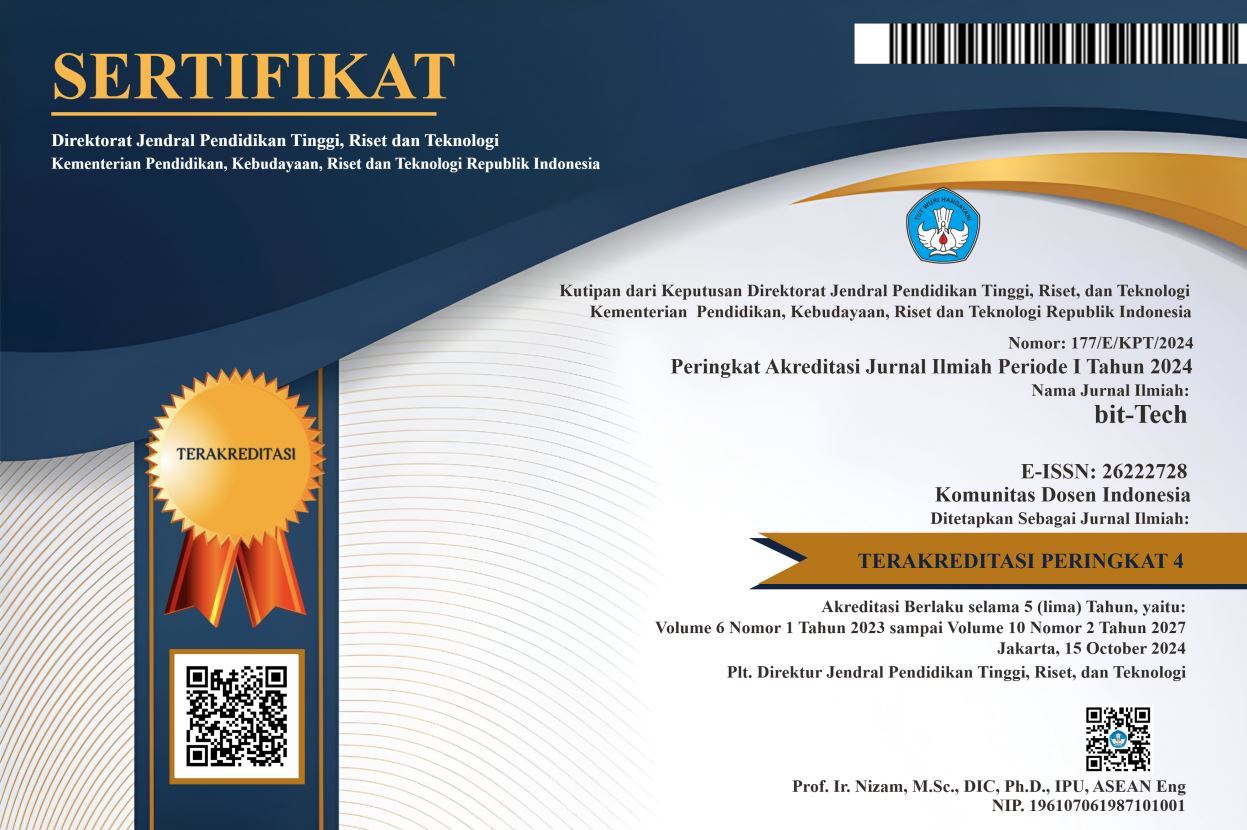Designing Home Security With Esp32-Cam and IoT-Based Alarm Notification Using Telegram
DOI:
https://doi.org/10.32877/bt.v6i2.932
Keywords:
ESP32-CAM, Internet of Things, Security, Passive InfraRed Censorship, Telegram Bot
Abstract
Nowadays, technological advances have entered human life. One of the security system solutions is the use of Closed Circuit Television (CCTV) as a monitoring medium, but it is still lacking. This is because more and more crimes are committed in homes where the owner is away. As a result, each home needs a security system that can protect the wealth and assets of the owner. Similarly, currently existing security systems are rarely able to provide data directly to homeowners if an outsider wants to commit a crime. So, research was conducted with the title "Home Security Design with ESP32-CAM and Internet of Things (IoT) Based Alarm Notification Using Telegram Application". With this device plan, it is believed that individuals who leave the house will feel safer. This device can detect an infrared wave produced by humans within its range and is equipped with an alarm/buzzer that produces output in the form of notifications on Telegram and alarm sounds on the device. The PIR sensor and ESP32-CAM integrated with the Telegram mobile device form the basis of this security system. This research has successfully implemented a device aimed at reducing home burglary issues by detecting human motion, triggering alarms, and enabling remote monitoring through Telegram. Additionally, the adapter utilized in the system produces an average voltage value of 5.196 V with an average error rate of approximately 3.9%.
Downloads
References
M. Ardiansyah, A. Febryan, Andriani, dan Rahmania, “Rancang Bangun Sistem Keamanan Rumah Berbasis Telegram Menggunakan Esp 32 Cam,” VERTEX ELEKTRO-Jurnal Tek. Elektro UNIMUH, vol. 15, no. 1, hal. 64–71, 2023, [Daring]. Tersedia pada: https://journal.unismuh.ac.id/index.php/vertex/article/view/10246/5624
F. Masykur dan F. Prasetiyowati, “Aplikasi Rumah Pintar ( Smart Home ) Pengendali Peralatan,” J. Teknol. Inf. dan Ilmu Komput., vol. 3, no. 1, hal. 51–58, 2018.
H. Isyanto dan M. Syahrullah, “Perancangan Security Home (Keamanan pada Rumah) Menggunakan Mikrokontroller Berbasis SMS (Short Message Service),” Resist. (elektRonika kEndali Telekomun. tenaga List. kOmputeR), vol. 1, no. 2, hal. 85, 2018, doi: 10.24853/resistor.1.2.85-96.
N. Nuraeni et al., “Sistem Akses Pintu Berbasis Face Recognition Menggunakan ESP32 Module dan Aplikasi Telegram,” J. Mediat., vol. 4, no. 3, hal. 115, 2021, doi: 10.26858/jmtik.v4i3.23700.
S. R. Devi Noviani, “Prototype Sistem Keamanan Rumah Berbasis Internet Of Things (Iot) Menggunakan Aplikasi Blynk,” Semin. Nas. Teknol. Inf. dan Komunikasi-2021, hal. 405–415, 2020, [Daring]. Tersedia pada: http://repository.ittelkom-pwt.ac.id/id/eprint/6045
K. Anggoro, J. Triyono, dan S. Raharjo, “Implementasi Iot Sistem Pemantauan Dan Kendali Pintu Otomatis Berdasarkan Kedekatan Objek,” J. Scr., vol. 9, no. 1, hal. 32–43, 2021.
J. Khatib, S. Dalam, dan K. Kunci, “Keamanan Rumah Menggunakan Sensor Passive Infrared Receiver dan SMS,” vol. 11, no. 1, hal. 1028–1036, 2022.
D. Vincensius dan B. Wasito, “Analisis Dan Perancangan Sistem Informasi Point Of Sales Pada CV. Senjaya Abadi,” J. Inform. dan Bisnis, vol. 1, no. 1, hal. 1–10, 2019.
M. S. Aziz, N., Pribadi, G., & Nurcahya, “Analisa dan Perancangan Aplikasi Pembelajaran Bahasa Inggris Dasar Berbasis Android,” J. IKRAITH-INFORMATIKA, vol. 1, no. 3, hal. 107–115, 2020.
R. Y. F. Nurul Samania, Nirsal, “RANCANG BANGUN APLIKASI E-VOTING PEMILIHAN KETUA UMUM HIMPUNAN MAHASISWA INFORMATIKA (HMTI) UNIVERSITAS COKROAMINOTO PALOPO BERBASIS WEBSITE,” J. Ilm. d’Computare, vol. 21, no. 1, hal. 1–9, 2020.
M. Syahputra Novelan, Z. Syahputra, dan P. H. Putra, “Sistem Kendali Lampu Menggunakan NodeMCU dan Mysql Berbasis IOT (Internet Of Things),” J. Nas. Inform. dan Teknol. Jar., vol. 5, no. 1, hal. 117–121, 2020, [Daring]. Tersedia pada: https://doi.org/10.30743/infotekjar.v5i1.2976
S. A. Arrahma dan R. Mukhaiyar, “Pengujian Esp32-Cam Berbasis Mikrokontroler ESP32,” Jtein, vol. 4, no. 1, hal. 60–66, 2023.
D. Desmira, D. Aribowo, W. D. Nugroho, dan S. Sutarti, “Penerapan Sensor Passive Infrared (Pir) Pada Pintu Otomatis Di Pt Lg Electronic Indonesia,” PROSISKO J. Pengemb. Ris. dan Obs. Sist. Komput., vol. 7, no. 1, 2020, doi: 10.30656/prosisko.v7i1.2123.
A. Nur Alfan dan V. Ramadhan, “Prototype Detektor Gas Dan Monitoring Suhu Berbasis Arduino Uno,” PROSISKO J. Pengemb. Ris. dan Obs. Sist. Komput., vol. 9, no. 2, hal. 61–69, 2022, doi: 10.30656/prosisko.v9i2.5380.
D. Susilo, C. Sari, dan G. W. Krisna, “Sistem Kendali Lampu Pada Smart Home Berbasis IOT (Internet of Things),” ELECTRA Electr. Eng. Artic., vol. 2, no. 1, hal. 23, 2021, doi: 10.25273/electra.v2i1.10504.
M. Pardede, E. Hutajulu, dan R. Sirait, “Sistem Pemantauan dan Pengendali Lampu Ruangan Laboratorium Berbasis NodeMCUESP8266 dengan Aplikasi Telegram Bot,” RELE (Rekayasa Elektr. dan Energi) J. Tek. Elektro, vol. 4, no. 2, hal. 134–142, 2022, doi: 10.30596/rele.v4i2.9562.
Q. Budiman, S. Mouton, L. Veenhoff, dan A. Boersma, “ANALISIS PENGENDALIAN MUTU DI BIDANG INDUSTRI MAKANAN (Studi Kasus: UMKM Mochi Kaswari Lampion Kota Sukabumi),” J. Inov. Penelit., vol. 1, no. 0.1101/2021.02.25.432866, hal. 1–15, 2021.
Downloads
Published
How to Cite
Issue
Section
License
Copyright (c) 2023 bit-Tech : Binary Digital - Technology

This work is licensed under a Creative Commons Attribution-ShareAlike 4.0 International License.
I hereby assign and transfer to bit-Tech all exclusive copyright ownership rights to the above work. This includes, but is not limited to, the right to publish, republish, downgrade, distribute, transmit, sell, or use the work and other related materials worldwide, in whole, or in part, in all languages, in electronic, printed, or any other form of media, now known or hereafter developed and reserves the right to permit or license a third party to do any of the above. I understand that this exclusive right will belong to bit-Tech from the date the article is accepted for publication. I also understand that bit-Tech, as the copyright owner, has sole authority to license and permit reproduction of the article. I understand that, except for copyright, any other proprietary rights associated with the work (e.g. patents or other rights to any process or procedure) must be retained by the author. In addition, I understand that bit-Tech permits authors to use their papers in any way permitted by the applied Creative Commons license.


 DOI :
DOI :
 Abstract views: 829
/
Abstract views: 829
/  PDF downloads: 573
PDF downloads: 573











